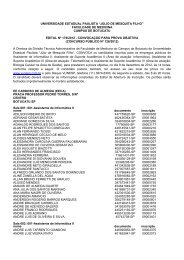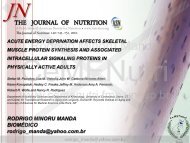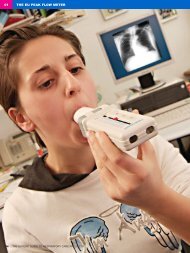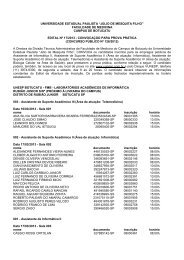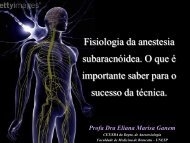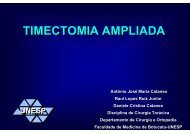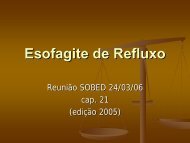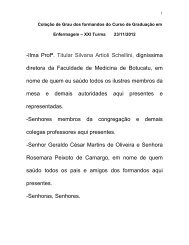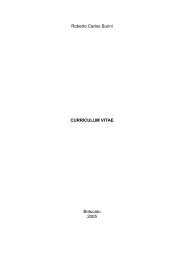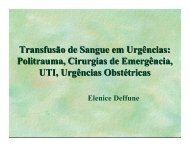Anestesia fora do Centro Cirúrgico - Escola Médica Virtual da ...
Anestesia fora do Centro Cirúrgico - Escola Médica Virtual da ...
Anestesia fora do Centro Cirúrgico - Escola Médica Virtual da ...
You also want an ePaper? Increase the reach of your titles
YUMPU automatically turns print PDFs into web optimized ePapers that Google loves.
Jorna<strong>da</strong> Paulista de <strong>Anestesia</strong> Pediátrica 2006<br />
<strong>Anestesia</strong> <strong>fora</strong> <strong>do</strong> <strong>Centro</strong> Cirúrgico<br />
Profa Dra Norma Sueli Pinheiro Mó<strong>do</strong>lo<br />
UNESP – Facul<strong>da</strong>de de Medicina de Botucatu – Depto. de Anestesiologia
<strong>Anestesia</strong> <strong>fora</strong> <strong>do</strong> <strong>Centro</strong> Cirúrgico<br />
Vários ambientes:<br />
• uni<strong>da</strong>des de emergência<br />
• en<strong>do</strong>scopias<br />
• diagnóstico por imagem<br />
• lab. cardiologia<br />
• consultório
Questões<br />
• Sinto-me tranqüilo em anestesiar crianças neste<br />
local?<br />
• É seguro?<br />
• Posso dizer para a família que é tão seguro quanto?<br />
• Acredito que a experiência <strong>da</strong> família será melhor?<br />
Gooden CK. Semin Anesth,<br />
Perioperative Med and Pain, 2006; 25:2-6.
Papel <strong>do</strong> Anestesiologista<br />
• realizar a técnica<br />
• criar, revisar e organizar<br />
• guidelines<br />
• regulamentar (Comissões de Acreditação)<br />
Kaplan, 2006
Regulamentações Atuais<br />
• Avaliação antes <strong>da</strong> se<strong>da</strong>ção<br />
• Candi<strong>da</strong>to apropria<strong>do</strong> para se<strong>da</strong>ção<br />
• Reavaliação<br />
• Local de admissão e recuperação<br />
• Comunicação e planejamento <strong>da</strong> se<strong>da</strong>ção entre os membros <strong>da</strong><br />
equipe<br />
• Educação <strong>do</strong> paciente no aspecto de opções e risco<br />
• Monitorizar o esta<strong>do</strong> físico<br />
• Avaliação <strong>do</strong> esta<strong>do</strong> físico após procedimento e alta<br />
• Resulta<strong>do</strong>s anota<strong>do</strong>s para melhorar os cui<strong>da</strong><strong>do</strong>s com o paciente<br />
Kaplan 2006 – ASA Refresher Courses
ASA & JCAHO<br />
Se<strong>da</strong>ção<br />
mínima/<br />
ansiólise<br />
(acor<strong>da</strong><strong>da</strong>)<br />
responde<br />
normal/<br />
aos coman<strong>do</strong>s<br />
verbais<br />
Se<strong>da</strong>ção<br />
modera<strong>da</strong>/<br />
analgesia<br />
(se<strong>da</strong>ção<br />
consciente)<br />
responde ao<br />
chama<strong>do</strong><br />
(coman<strong>do</strong><br />
verbal) ou<br />
toque leve<br />
Se<strong>da</strong>ção<br />
profun<strong>da</strong>/<br />
analgesia<br />
responde a<br />
chama<strong>do</strong>s<br />
repeti<strong>do</strong>s ou<br />
estímulo<br />
<strong>do</strong>loroso<br />
<strong>Anestesia</strong><br />
geral<br />
não responde<br />
sem reflexos<br />
Kaplan, 2006
Guidelines<br />
Candi<strong>da</strong>tos → ASA I e II<br />
III e IV → requer recomen<strong>da</strong>ção especial<br />
Facili<strong>da</strong>des → Suporte e treinamento em emergências pediátricas<br />
Equipamento → Manuseio de via aérea com tratamento apropria<strong>do</strong><br />
Oxímetro de pulso<br />
Monitor de pressão<br />
Aspira<strong>do</strong>r<br />
Carrinho de emergência<br />
(drogas e materiais)<br />
Local → Apropria<strong>do</strong> com equipamentos adequa<strong>do</strong>s<br />
Jejum → Regras apropria<strong>da</strong>s<br />
Kaplan – ASA Refresher Courses, 2002
Guidelines<br />
Quem realiza →<br />
Se<strong>da</strong>ção modera<strong>da</strong> → responsável pelo tratamento<br />
<strong>da</strong>s complicações<br />
BLS é man<strong>da</strong>tório<br />
PALS é recomen<strong>da</strong><strong>do</strong><br />
Assistente para observar monitor e aju<strong>da</strong>r no<br />
procedimento<br />
Se<strong>da</strong>ção profun<strong>da</strong> → responsável deve monitorar<br />
sinais vitais, vias aéreas, administrar drogas<br />
BLS é man<strong>da</strong>tório<br />
PALS é recomen<strong>da</strong><strong>do</strong><br />
Kaplan – ASA Refresher Courses, 2002
Guidelines<br />
Documentação →<br />
ANTES → Avaliação clínica<br />
ASA<br />
Sinais vitais<br />
Consentimento pós-informa<strong>do</strong><br />
DURANTE→Se<strong>da</strong>ção modera<strong>da</strong> – intervalo para<br />
observar sinais vitais (SaO 2 , FR,<br />
FC, PA), drogas administra<strong>da</strong>s<br />
Se<strong>da</strong>ção profun<strong>da</strong> → observação<br />
contínua. Anotar ca<strong>da</strong> 5’ até a<br />
criança voltar ao esta<strong>do</strong> de pré<br />
se<strong>da</strong>ção<br />
APÓS → <strong>do</strong>cumentar critérios de alta<br />
Kaplan – ASA Refresher Courses, 2002<br />
Krauss & Green – New Engl J Med, 2000<br />
Committe on Drugs – Pediatrics, 1992
Pediatrics 2006; 118:1087-1096
Pediatrics 2006; 118:1087-1096<br />
Quem realizou % n<br />
Anestesiologista 19,2 5781<br />
Enfermeira 9,7 2907<br />
Médico PS 27,9 8378<br />
Residente 3,9 1172<br />
Intensivista 28,4 8535<br />
Pediatria 6,9 2071<br />
Radiologia 2,1 616<br />
Outros 0,9 256<br />
<strong>da</strong><strong>do</strong>s perdi<strong>do</strong>s 0,001 5
Pediatrics 2006; 118:1087-1096<br />
Complicações<br />
Incidência por<br />
10.000<br />
Vômitos durante 47,2 14,2<br />
Dessaturação (< 90%) 156,5 470<br />
Total eventos 339,6 1020<br />
n
Pediatrics 2006; 118:1087-1096<br />
Tratamentos não planeja<strong>do</strong>s<br />
Incidência por<br />
10.000<br />
n<br />
Reversão agente 1,7 5<br />
Necessi<strong>da</strong>de chamar anestesiologista para via aérea 2,0 6<br />
Admissão hospitalar não prolonga<strong>da</strong> 7,0 21<br />
Necessi<strong>da</strong>de intubação (não planeja<strong>da</strong>) 9,7 29<br />
Via aérea (oral) 27,6 83<br />
Ventilação com máscara 63,9 192<br />
Total 111,9 336<br />
Condições durante o procedimento<br />
Incidência por<br />
10.000<br />
n<br />
Se<strong>da</strong>ção inadequa<strong>da</strong> 88,9 267
Pediatrics 2006; 118:1087-1096<br />
Jejum<br />
NPO para líqui<strong>do</strong>s % n<br />
< 2 1,4 426<br />
2 – 4 23,9 7186<br />
4 – 6 14,4 4327<br />
6 – 8 10,4 3132<br />
> 8 46,6 13996<br />
<strong>da</strong><strong>do</strong>s perdi<strong>do</strong>s 3,9 370
Pediatrics 2006; 118:1087-1096<br />
Jejum<br />
NPO para sóli<strong>do</strong>s % n<br />
< 2 0,2 66<br />
2 – 4 0,8 232<br />
4 – 6 3,9 1168<br />
6 – 8 17 5108<br />
> 8 75,2 22591<br />
<strong>da</strong><strong>do</strong>s perdi<strong>do</strong>s 2,9 872
Pediatrics 2006; 118:1087-1096<br />
Complicações<br />
Efeitos adversos % n<br />
Morte 0 0<br />
PC 0,3 1<br />
Aspiração 0,3 1<br />
Hipotermia 1,3 4<br />
Convulsão 2,7 8<br />
Estri<strong>do</strong>r 4,3 11<br />
Laringoespasmo 4,3 11<br />
Espirros 4,7 14<br />
Reação alérgica 5,7 16<br />
Complicações Drogas EV 11 33<br />
Se<strong>da</strong>ção prolonga<strong>da</strong> 13,6 41<br />
Recuperação prolonga<strong>da</strong> 22,3 67<br />
Apnéia 24,3 73<br />
Secreções 41,6 125
Pediatrics 2006; 118:1087-1096<br />
Analgésicos e Se<strong>da</strong>tivos<br />
Se<strong>da</strong>tivos/analg % nº de vezes utiliza<strong>do</strong>s<br />
Ativan 0,2 46<br />
H. Cloral 11,7 3507<br />
Dex 1,3 393<br />
Etomi<strong>da</strong>to 2,1 639<br />
Cetamina 13,6 4075<br />
Metohexital 0,4 113<br />
Mi<strong>da</strong>zolam 27,1 8142<br />
Pentobarbital 13,2 3953<br />
Propofol 50,1 15059<br />
Tiopental 0,5 151<br />
Fentanil 8 54<br />
Meperidina 0,2 552<br />
Morfina 1,8 9<br />
Remifentanil 0,3 77
Vol. 106(4): 633-644; 2000
Resulta<strong>do</strong>s x Vias de Administração<br />
Resulta<strong>do</strong><br />
Morte (M)<br />
Lesão (L)<br />
EV Oral IM Retal Subc Nasal Inalação Submucosa<br />
Não<br />
relata<strong>do</strong><br />
ML T ML T ML T ML T ML T ML T ML T ML T ML T ML T<br />
Total<br />
Opióide 9 22 4 4 8 10 - - 1 1 - - - - - - 1 1 23 38<br />
Benzodzp 9 23 4 4 1 1 - - - - 4 4 - - - - 3 4 22 37<br />
Se<strong>da</strong>tivo/<br />
hipnótico<br />
3 3 17 24 13 16 1 2 - - - - - - - - - - 34 45<br />
Barbitúric 10 10 2 2 1 1 1 2 - - - - - - - - 1 1 20 21<br />
Cetamina 0 2 0 3 1 3 - - - - - - - - - - 1 1 2 9<br />
A Inalatór - - - - - - - - - - - - 12 13 - - - - 12 13<br />
A Locais - - - - - - - - 2 2 - - - - 9 10 - - 11 14<br />
Total 31 30 27 37 24 31 7 9 3 3 4 4 12 13 9 12 7 8 - -<br />
% evento<br />
adverso<br />
52 73 77 78 100 100 92
Eventos Adversos <strong>da</strong><br />
Se<strong>da</strong>ção em Pediatria<br />
categoria <strong>da</strong> droga<br />
vias de adm<br />
correlação<br />
negativa<br />
3 medicações<br />
ou mais<br />
correlação<br />
positiva<br />
Cotè et al - Pediatrics 2000
Eventos Adversos <strong>da</strong><br />
Se<strong>da</strong>ção em Pediatria<br />
34 pacientes<br />
(39% <strong>da</strong>s 170 administrações de drogas)<br />
1,25 x acima <strong>da</strong> <strong>do</strong>se máxima<br />
recomen<strong>da</strong><strong>da</strong><br />
Cotè et al - Pediatrics 2000
Vol. 105(4): 805-814; 2000
Local <strong>do</strong>s Eventos<br />
Eventos<br />
Local<br />
Hospital<br />
Não<br />
cç mais velha e saudável<br />
Respiratórios 80% 80%<br />
Cardíacos 14% 56,3%<br />
Outros 7% 14%<br />
Ressucitação inadequa<strong>da</strong> 2,3% 57,1%<br />
Morte e lesão permanente 37,2% 92,8%
Critérios de Alta<br />
1. Estabili<strong>da</strong>de cardiovascular<br />
2. Vias aéreas pérvias, freqüência respiratória e VM<br />
adequa<strong>do</strong>s<br />
3. Paciente facilmente desperto<br />
4. Reflexos protetores íntegros<br />
5. O paciente pode conversar (i<strong>da</strong>de apropria<strong>da</strong>)<br />
6. O paciente consegue sentar (i<strong>da</strong>de apropria<strong>da</strong>)<br />
7. Nível de responsivi<strong>da</strong>de pré-se<strong>da</strong>ção ou perto disso<br />
8. Hidratação adequa<strong>da</strong><br />
Pediatrics, 1992<br />
9. Normotermia<br />
Clin Ped Am North, 1994
Conclusões <strong>da</strong> FDA e Outros<br />
Estu<strong>do</strong>s<br />
• To<strong>do</strong>s se<strong>da</strong>tivos e narcóticos causam problemas mesmo em <strong>do</strong>ses<br />
recomen<strong>da</strong><strong>da</strong>s;<br />
• To<strong>da</strong>s áreas que realizam se<strong>da</strong>ção têm relata<strong>do</strong> eventos adversos;<br />
• Crianças 1 a 5 anos de i<strong>da</strong>de são de maior risco, mesmo sem ter<br />
<strong>do</strong>ença concomitante;<br />
• Depressão respiratória e obstrução <strong>da</strong>s vias aéreas são os eventos<br />
adversos mais freqüentes;<br />
• Eventos adversos envolvem: múltiplos fármacos, over<strong>do</strong>se,<br />
avaliação e monitorização inadequa<strong>da</strong>s, ausência de regras<br />
práticas e alta precoce.<br />
Kaplan, 2006<br />
ASA Refresher Courses
Obriga<strong>da</strong>




